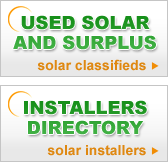|
Indoor Solar LightingLighting BasicsIncandescent bulbs are inexpensive, but inefficient. When a light switch is flipped on, an electric current passes through a tungsten filament. The resulting resistance creates heat, causing the filament to “incandesce,” or glow. Because incandescent bulbs provide light by heating a solid material, most of the consumed energy is released as heat. Incandescent output spans from 16 lm/W for a household tungsten bulb to 22 lm/W for a halogen bulb. Tungsten halogen lamps use refined incandescent technology to increase energy efficiency. While the filament in a traditional incandescent lamp leaves deposits on the wall of the bulb that decrease light output, high-pressured halogen gas lamps slow filament deterioration and redeposit evaporated tungsten on the filament. This prevents the filament from thinning and breaking as easily. Halogen lamps appear brighter and whiter because of high color temperatures containing blue and green. Impervious to temperature, halogen lamps have no problem starting up in cold weather. Fluorescent lights excite mercury gas with electricity, which produces UV light. This UV light in turn causes phosphor to "fluoresce" and create visible light. They provide high luminous efficacy, long service life, and excellent color characteristics. Fluorescent tubes provide an average of 60 lm/W, but the tubes are bulky and fragile. They also require starter or ballast circuits that may buzz audibly. Standard fluorescent lights need at least 50 degrees Fahrenheit to operate and work best at temperatures exceeding 60 degrees Fahrenheit. This makes outdoor fluorescent application problematic/ better suited to indoor lighting needs. There is a strong trend toward compact fluorescent lamps (CFLs) for household use because they last at least four to five times longer than incandescent lamps using only one-third the wattage. For example, an 18w compact fluorescent produces the same number of lumens as a 75w incandescent. CFLs are designed to fit in standard sockets, come in large varieties of shapes and sizes, and include a quiet, integrated ballast. For enhanced color quality, choose a higher-wattage CFL. Extremely efficient light-emitting diode (LED) technology has several advantages over traditional incandescent and fluorescent lighting methods. LEDs emit light, not heat, when electricity passes through them, which reduces energy waste. One LED lamp emitter uses 0.2 watts of electricity. LED lamps consist of anywhere between 8 to 50+ small LED lamps within one bulb. One 6w LED bulb can last over 60,000 hours more than a 60w incandescent bulb. Ratings reach 100,000 hours. LED lamps are designed to never burn out over the lifetime of the product, which is usually 25 years. Small clusters of white, long-life LEDs are used to replace incandescent bulbs and fluorescent lamps or tubes in a system called solid-state lighting (SSL). Average SSL output is 32 lumens per watt (lm/W), extending to 80 lm/W in commercial applications. Architectural applications average 56 lumens per watt, which is comparable to fluorescent systems. LEDs cast a different type of illumination than conventional lights. For stronger light, consider fixtures with multiple LEDs. While garden accent lighting may require only one LED per fixture, strong safety and path lighting may use three or more LEDs per fixture. High pressure sodium lighting is a type of high-intensity discharge lighting common in outdoor applications. High-pressure sodium lamps have an efficacy of 50–140 lumens per watt—an efficiency exceeded only by low-pressure sodium lamps. They produce a warm orange glow. Low pressure sodium lighting is very energy efficient
but is monochromatic, emitting a single orange color. Their runhour
life is well over 30,000 hours. Typical applications include street,
highway and security lighting. Like high-intensity discharge lighting,
low-pressure sodium lamps have a ten-minute start time and have to cool
before they can restart. Therefore, they are most suitable for applications
where they stay on for hours at a time. They are not well-suited for
use with motion detectors.
 |








